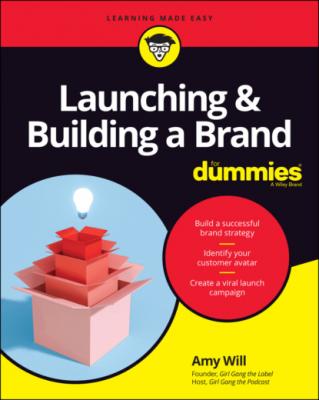ТОП просматриваемых книг сайта:
Launching & Building a Brand For Dummies. Amy Will
Читать онлайн.Название Launching & Building a Brand For Dummies
Год выпуска 0
isbn 9781119748052
Автор произведения Amy Will
Жанр Малый бизнес
Издательство John Wiley & Sons Limited
In this section, I introduce you to various sources of financing. But before you even think about exploring available financing options, create a budget so that you’ll know just how much money you’ll need.
Budgeting for your business/brand
To budget for your business/brand, create a list of everything you need to make it a success, research prices, and then add everything up. Table 2-1 contains a list of items to get you started. Depending on the business/brand you’re creating, you may need to add to the list or cross off some items. When you have a comprehensive list, research the cost for each item/service (on the web or by calling around), and write the estimated cost in the right column.
TABLE 2-1 Business/brand budget
| Item | Cost |
|---|---|
| Legal fees (for incorporation, registration, licenses, and intellectual-property protections) | |
| Accounting fees (if you plan to hire an accountant) | |
| Brand design (logo and graphics) | |
| Website/blog (design, build, and host) | |
| Marketing/advertising (online ads) | |
| Materials/equipment/supplies | |
| Manufacturing/product sourcing (if you’ll be selling an original product) | |
| Staff (if you’re planning to hire people) | |
| Rent (for a bricks-and-mortar business or retail store) |
CREATING A SELF-FUNDED BRAND
A self-funded brand isn’t one that funds itself, but one that you fund. The benefit of creating a self-funded brand is that you have total control of all business/brand decisions, and you get to keep 100 percent of the profits. Woo-hoo!
Unfortunately, the potential benefits are outnumbered by the drawbacks:
You’re responsible for all business/brand decisions.
You suffer 100 percent of any losses.
You have limited access to financing to fuel growth and pursue opportunities.
Creating a business plan
When you’re seeking any type of financing for your business/brand, a business plan is essential. Nobody (except maybe your parents or your rich Aunt Matilda) will hand you money just because you ask for it. Banks, investors, and organizations want to know that their money will be put to good use. Banks want some assurance that your loan will be paid back. Investors want a reasonable expectation that they’ll receive a return on their investment.
If you don’t already have a business/brand in place to demonstrate a proven track record of success, you need a convincing business plan. Creating a business plan is beyond the scope of this book, but make sure that your plan contains the following key elements:
Summary: The summary should include what your business/brand is and does, and why it’s better than the competition; your bio and experience (and that of any partners or associates); the products/services you offer; and why you think your business/brand will be successful.
Strategy, goals, objectives, and activities: Your strategy is your big plan or idea of how you’re going to achieve success. Goals are what you need to accomplish to execute your strategy. Objectives are measurable milestones you must meet to reach your goals. And activities are what you’ll do to meet your objectives.
Market/competitive analysis: This analysis describes the industry or market and any existing competition, and shows how your brand is different from and better than what’s already available.
Financial projections: This element is your budget to start and run the business (costs), how much money you’re expecting to pull in (revenue), projected profit (revenue minus costs), and how you plan to pay back any loans or reward investors. Prepare for setbacks, unexpected costs, and missed goals to protect yourself from underdelivering. It’s best to set benchmarks that have a margin for error to make sure everyone involved can understand the full scope of the plan.
For detailed guidance on creating a business plan, check out Creating a Business Plan For Dummies, by Veechi Curtis (John Wiley & Sons, Inc.).
Getting grants
Depending on your business/brand, you may be able to get a grant to finance it. A grant is free money; you never have to pay it back! Organizations offer grants for all sorts of reasons, such as to stimulate the economy, improve communities, and empower certain demographics (such as women in business).
The first step in getting a grant is finding one you qualify for. Here’s a short list to get you started:
Government grants: Federal and state agencies make a point of stating that they’re not sources of free money for most business startups, but they offer limited grants to fund scientific or medical research and community, educational, and environmental programs. Here are a few resources for finding out more about government grants:SBA Grants page (https://www.sba.gov/funding-programs/grants)U.S. Economic Development Administration’s Funding Opportunities page (https://eda.gov/funding-opportunities)The State Business Incentive Database from the Council for Community and Economic Research (www.stateincentives.org)The SBA’s Small Business Development Centers database, which you can search at https://www.sba.gov/local-assistanceYour state’s .gov website
Demographic-specific grants: If you’re a woman, veteran, or minority business owner, you may be eligible for grants from corporations, special-interest groups, or the SBA. Search the web for “business grants for” followed by your demographic, such as “business grants for women.”
Corporation grants: Many corporations offer small-business grants or sponsor contests to encourage innovation in their industry or help entrepreneurs in certain groups start a business. Check with the big players in your industry to see whether they offer any grant programs or contests,

